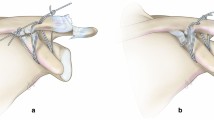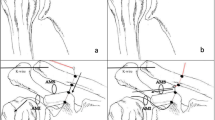Abstract
Purpose
We present the functional and clinical results of a combined surgical technique that functionally restores chronic Acromioclavicular Joint Instability (AJI). The method combines a double-looped suture fixation augmented with a semitendinosus autograft.
Methods
Between 2017 and 2021, 15 patients were treated using the surgical technique. All patients suffered an Acromioclavicular Joint Separation that remained untreated for at least 6 (6–16) weeks after the initial injury. Four Ethibond sutures were passed below the coracoid process and through a 4.5 drill hole in the clavicle. The sutures provided adequate horizontal and vertical reduction and stabilization of the clavicle. A semitendinosus autograft was passed below the coracoid process and looped around the clavicle. The remaining graft limbs were used to reconstruct the acromioclavicular capsule. Patients were radiologically evaluated with bilateral anteroposterior (AP), Zanca, and Alexander views. The clinical evaluation was based on the Acromioclavicular Joint Instability Score and the Constant-Murley Score.
Results
The mean follow-up period was 31.2 months (17–61). The mean last ACJIS and CMS scores were 96 (90–100) and 97.67 (87–100), respectively. Reduction of the clavicle was radiologically confirmed in all cases throughout the follow-up period. AC arthritis was reported in 1 case without associated clinical symptoms. No significant complications were reported, and all patients returned to the pre-injury activity level.
Conclusion
The presented functional reconstruction of the AC joint disruption in chronic cases is an effective and secure method with low complication rates and good clinical results.
Level of Evidence III
This journal requires that authors assign a level of evidence to each article. For a full description of these Evidence-Based Medicine ratings, please refer to the Table of Contents or the online Instructions to Authors www.springer.com/00266.







Similar content being viewed by others

Change history
18 March 2024
A Correction to this paper has been published: https://doi.org/10.1007/s00590-024-03886-x
References
Kiel J, Taqi M, Kaiser K (2022) Acromioclavicular Joint Injury. In: StatPearls. StatPearls Publishing. Retrieved from 14 Jan 2023 from https://www.ncbi.nlm.nih.gov/books/NBK493188/
Rockwood CA Jr (1984) Fractures and dislocations of the shoulder. In: Rockwood CA Jr, Green DP (eds) Fractures in adults. PA: Lippincott, Philadelphia, pp 860–910
Gorbaty JD, Hsu JE, Gee AO (2016) Classifications in brief: rockwood classification of acromioclavicular joint separations. Clin. Orthop. Relat. Res. 475(1):283–287. https://doi.org/10.1007/s11999-016-5079-6
Dyrna F, Imhoff FB, Haller B, Braun S, Obopilwe E, Apostolakos JM, Morikawa D, Imhoff AB, Mazzocca AD, Beitzel K (2018) Primary stability of an acromioclavicular joint repair is affected by the type of additional reconstruction of the acromioclavicular capsule. Am J Sports Med 46(14):3471–3479. https://doi.org/10.1177/0363546518807908
Hislop P, Sakata K, Ackland DC, Gotmaker R, Evans MC (2019) Acromioclavicular joint stabilization: a biomechanical study of bidirectional stability and strength. Orthop J Sports Med 7(4):232596711983675. https://doi.org/10.1177/2325967119836751
Dyrna FGE, Imhoff FB, Voss A, Braun S, Obopilwe E, Apostolakos JM, Morikawa D, Comer B, Imhoff AB, Mazzocca AD, Beitzel K (2018) The integrity of the acromioclavicular capsule ensures physiological centering of the acromioclavicular joint under rotational loading. Am J Sports Med 46(6):1432–1440. https://doi.org/10.1177/0363546518758287
Morikawa D, Dyrna F, Cote MP, Johnson JD, Obopilwe E, Imhoff FB, Beitzel K, Mazzocca AD, Scheiderer B (2018) Repair of the entire superior acromioclavicular ligament complex best restores posterior translation and rotational stability. Knee Surg Sports Traumatol Arthrosc 27(12):3764–3770. https://doi.org/10.1007/s00167-018-5205-y
Gumina S, Carbone S, Postacchini F (2009) Scapular dyskinesis and SICK scapula syndrome in patients with chronic type III acromioclavicular dislocation. Arthroscopy 25(1):40–45. https://doi.org/10.1016/j.arthro.2008.08.019
Tauber M, Valler D, Lichtenberg S, Magosch P, Moroder P, Habermeyer P (2015) Arthroscopic stabilization of chronic acromioclavicular joint dislocations. Am J Sports Med 44(2):482–489. https://doi.org/10.1177/0363546515615583
Garofalo R, Ceccarelli E, Castagna A, Calvisi V, Flanagin B, Conti M, Krishnan SG (2017) Open capsular and ligament reconstruction with semitendinosus hamstring autograft successfully controls superior and posterior translation for type V acromioclavicular joint dislocation. Knee Surg Sports Traumatol Arthrosc 25(7):1989–1994. https://doi.org/10.1007/s00167-017-4509-7
Beitzel K, Cote MP, Apostolakos J, Solovyova O, Judson CH, Ziegler CG, Edgar CM, Imhoff AB, Arciero RA, Mazzocca AD (2013) Current concepts in the treatment of acromioclavicular joint dislocations. Arthroscopy 29(2):387–97. https://doi.org/10.1016/j.arthro.2012.11.023
Nolte PC, Lacheta L, Dekker TJ, Elrick BP, Millett PJ (2020) Optimal management of acromioclavicular dislocation: current perspectives. Orthop Res Rev 12:27–44. https://doi.org/10.2147/orr.s218991
Grutter PW, Petersen SA (2005) Anatomical acromioclavicular ligament reconstruction. Am J Sports Med 33(11):1723–1728. https://doi.org/10.1177/0363546505275646
Mazzocca AD, Conway JE, Johnson S, Rios CG, Dumonski ML, Santangelo SA, Arciero RA (2004) The anatomic coracoclavicular ligament reconstruction. Oper Tech Sports Med 12(1):56–61. https://doi.org/10.1053/j.otsm.2004.04.001
Lee SJ, Nicholas SJ, Akizuki KH, McHugh MP, Kremenic IJ, Ben-Avi S (2003) Reconstruction of the coracoclavicular ligaments with tendon grafts: a comparative biomechanical study. Am J Sports Med 31(5):648–654. https://doi.org/10.1177/03635465030310050301
Saccomanno MF, Fodale M, Capasso L, Cazzato G, Milano G (2014) Reconstruction of the coracoclavicular and acromioclavicular ligaments with semitendinosus tendon graft: a pilot study. Joints 2(1):6–14
Mazzocca AD, Santangelo SA, Johnson ST, Rios CG, Dumonski ML, Arciero RA (2006) A Biomechanical evaluation of an anatomical coracoclavicular ligament reconstruction. Am J Sports Med 34(2):236–246. https://doi.org/10.1177/0363546505281795
Costic RS, Labriola JE, Rodosky MW, Debski RE (2004) Biomechanical rationale for development of anatomical reconstructions of coracoclavicular ligaments after complete acromioclavicular joint dislocations. Am J Sports Med 32(8):1929–1936. https://doi.org/10.1177/0363546504264637
Hohmann E, Tetsworth K (2023) Clinical outcomes for grades III-V acromioclavicular dislocations favor double-button fixation compared to clavicle hook plate fixation: a systematic review and meta-analysis. Eur J Orthop Surg Traumatol 33(7):2831–2846. https://doi.org/10.1007/s00590-023-03492-3
Spiegl UJ, Smith SD, Euler SA, Dornan GJ, Millett PJ, Wijdicks CA (2014) Biomechanical consequences of coracoclavicular reconstruction techniques on clavicle strength. Am J Sports Med 42(7):1724–1730. https://doi.org/10.1177/0363546514524159
Rylander LS, Baldini T, Mitchell JJ, Messina M, Justl Ellis IA, McCarty EC (2014) Coracoclavicular ligament reconstruction: coracoid tunnel diameter correlates with failure risk. Orthopedics 37(6):e531-535. https://doi.org/10.3928/01477447-20140528-52
Dimakopoulos P, Panagopoulos A, Syggelos SA, Panagiotopoulos E, Lambiris E (2006) Double-loop suture repair for acute acromioclavicular joint disruption. Am J Sports Med 34(7):1112–1119. https://doi.org/10.1177/0363546505284187
Scheibel M, Dröschel S, Gerhardt C, Kraus N (2011) Arthroscopically assisted stabilization of acute high-grade acromioclavicular joint separations. Am J Sports Med 39(7):1507–1516. https://doi.org/10.1177/0363546511399379
Reintgen C, Gerlach EB, Schoch BS, Mamelson K, Wright TW, Farmer KW, King JJ (2020) What outcome measures are reported in the management of acromioclavicular joint injuries? Orthop J Sports Med 8(1):2325967119892322. https://doi.org/10.1177/2325967119892322
Dimakopoulos P, Panagopoulos A (2007) Functional coracoclavicular stabilization for acute acromioclavicular joint disruption. Orthopedics 30(2):103–108. https://doi.org/10.3928/01477447-20070201-08
Panagopoulos A, Fandridis E, Rose GD, Ranieri R, Castagna A, Kokkalis ZT (2020) Long-term stability of coracoclavicular suture fixation for acute acromioclavicular joint separation. Knee Surg Sports Traumatol Arthrosc 29(7):2103–2109. https://doi.org/10.1007/s00167-020-06158-3
Thomas K, Litsky A, Jones G, Bishop JY (2011) Biomechanical comparison of Coracoclavicular reconstructive techniques. Am J Sports Med 39(4):804–810. https://doi.org/10.1177/0363546510390482
Beitzel K, Mazzocca AD (2014) Offen anatomische Rekonstruktion der chronischen Akromioklavikularinstabilität. Oper Orthop Traumatol 26(3):237–244. https://doi.org/10.1007/s00064-013-0277-9
Wellmann M, Kempka JP, Schanz S, Zantop T, Waizy H, Rashke MJ, Petersen W (2009) Coracoclavicular ligament reconstruction: biomechanical comparison of tendon graft repairs to a synthetic double bundle augmentation. Knee Surg Sports Traumatol Arthrosc 17(5):521–528. https://doi.org/10.1007/s00167-009-0737-9
Kibler WB, Sciascia AD, Morris BJ, Dome DC (2017) Treatment of Symptomatic Acromioclavicular Joint Instability by a Docking Technique: Clinical Indications, Surgical Technique, and Outcomes. Arthroscopy 33(4):696-708e2. https://doi.org/10.1016/j.arthro.2016.08.023
Coale RM, Hollister SJ, Dines JS, Allen AA, Bedi A (2013) Anatomic considerations of transclavicular-transcoracoid drilling for coracoclavicular ligament reconstruction. J Shoulder Elbow Surg 22(1):137–144. https://doi.org/10.1016/j.jse.2011.12.008
Xue C, Zhang M, Zheng TS, Zhang GY, Fu P, Fang JH, Li X (2013) Clavicle and coracoid process drilling technique for truly anatomic coracoclavicular ligament reconstruction. Injury 44(10):1314–1320. https://doi.org/10.1016/j.injury.2013.06.022
Balke M, Wafaisade A, Hoeher J, Greshake O (2023) Minimally invasive reconstruction of acute acromioclavicular joint injuries using the Twin Bridge button system. Eur J Orthop Surg Traumatol 33(4):1349–1355. https://doi.org/10.1007/s00590-022-03293-0
Flint JH, Wade AM, Giuliani J, Rue JP (2013) Defining the terms acute and chronic in orthopaedic sports injuries: a systematic review. Am J Sports Med 42(1):235–241. https://doi.org/10.1177/0363546513490656
Muench LN, Kia C, Jerliu A, Murphy M, Berthold DP, Cote MP, Arciero RA, Mazzocca AD (2019) Functional and radiographic outcomes after anatomic coracoclavicular ligament reconstruction for type III/V acromioclavicular joint injuries. Orthop J Sports Med 7(11):232596711988453. https://doi.org/10.1177/2325967119884539
Rolf O, Hann von Weyhern A, Ewers A, Boehm TD, Gohlke F (2007) Acromioclavicular dislocation Rockwood III–V: results of early versus delayed surgical treatment. Arch Orthop Trauma Surg 128(10):1153–1157. https://doi.org/10.1007/s00402-007-0524-3
Song T, Yan X, Ye T (2014) Comparison of the outcome of early and delayed surgical treatment of complete acromioclavicular joint dislocation. Knee Surg Sports Traumatol Arthrosc 24(6):1943–1950. https://doi.org/10.1007/s00167-014-3225-9
Borbas P, Churchill J, Ek ET (2019) Surgical management of chronic high-grade acromioclavicular joint dislocations: a systematic review. J Shoulder Elbow Surg 28(10):2031–2038. https://doi.org/10.1016/j.jse.2019.03.005
Cisneros LN, Reiriz JS (2017) Management of chronic unstable acromioclavicular joint injuries. J Orthop Traumatol 18(4):305–318. https://doi.org/10.1007/s10195-017-0452-0
Weaver JK, Dunn HK (1972) Treatment of acromioclavicular injuries, especially complete acromioclavicular separation. J Bone Joint Surg Am 54(6):1187–1194
Rauschning W, Nordesjö LO, Nordgren B, Sahlstedt B, Wigren A (1980) Resection arthroplasty for repair of complete acromioclavicular separations. Arch Orthop Trauma Surg 97(3):161–164. https://doi.org/10.1007/BF00389721
Kawabe N, Watanabe R, Sato M (1984) Treatment of complete acromioclavicular separation by coracoacromial ligament transfer. Clin Orthop Relat Res 185:222–227
Harris RI, Wallace AL, Harper GD, Goldberg JA, Sonnabend DH, Walsh WR (2000) Structural properties of the intact and the reconstructed coracoclavicular ligament complex. Am J Sports Med 28(1):103–108. https://doi.org/10.1177/03635465000280010201
Weinstein DM, McCann PD, McIlveen SJ, Flatow EL, Bigliani LU (1995) Surgical treatment of complete acromioclavicular dislocations. Am J Sports Med 23(3):324–331. https://doi.org/10.1177/036354659502300313
Giannotti S, Dell’osso G, Bugelli G, Cazzella N, Guido G (2013) Surgical treatment of acromioclavicular dislocation with LARS artificial ligament. Eur J Orthop Surg Traumatol 23(8):873–876. https://doi.org/10.1007/s00590-012-1113-x
Carofino BC, Mazzocca AD (2010) The anatomic coracoclavicular ligament reconstruction: surgical technique and indications. J Shoulder Elbow Surg 19(2 Suppl):37–46. https://doi.org/10.1016/j.jse.2010.01.004
Fauci F, Merolla G, Paladini P, Campi F, Porcellini G (2013) Surgical treatment of chronic acromioclavicular dislocation with biologic graft vs synthetic ligament: a prospective randomized comparative study. J Clin Orthop Trauma 14(4):283–290. https://doi.org/10.1007/s10195-013-0242-2
Author information
Authors and Affiliations
Corresponding author
Ethics declarations
Conflict of interest
No conflict of interest to be declared. No funding to be declared.
Ethical approval
All participants gave their informed consent for inclusion in this study. The study was conducted in accordance with the Declaration of Helsinki.
Additional information
Publisher's Note
Springer Nature remains neutral with regard to jurisdictional claims in published maps and institutional affiliations.
Rights and permissions
Springer Nature or its licensor (e.g. a society or other partner) holds exclusive rights to this article under a publishing agreement with the author(s) or other rightsholder(s); author self-archiving of the accepted manuscript version of this article is solely governed by the terms of such publishing agreement and applicable law.
About this article
Cite this article
Kotsalis, G., Giatroudakis, K., Ladogianni, M. et al. Functional reconstruction of chronic acromioclavicular joint separation using a double suture technique combined with semitendinosus autograft. Eur J Orthop Surg Traumatol 34, 1635–1645 (2024). https://doi.org/10.1007/s00590-024-03850-9
Received:
Accepted:
Published:
Issue Date:
DOI: https://doi.org/10.1007/s00590-024-03850-9



